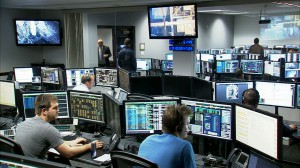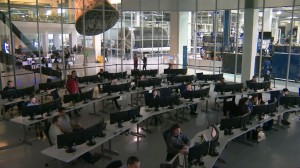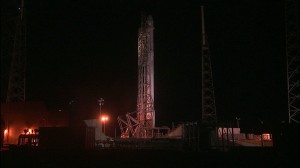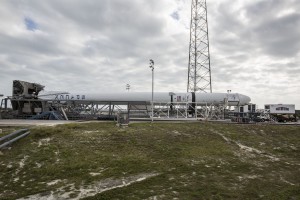 The Falcon 9 rocket is backdropped by the darkness of a predawn sky at Cape Canaveral Air Force Station’s Space Launch Complex 40.
The Falcon 9 rocket is backdropped by the darkness of a predawn sky at Cape Canaveral Air Force Station’s Space Launch Complex 40.
Month: January 2015
Less Than 30 Minutes to Go
With less than 30 minutes remaining until the planned 4:47 a.m. liftoff of the SpaceX Falcon 9 rocket, the countdown continues to go smoothly and activities are on schedule at Space Launch Complex 40 at Cape Canaveral Air Force Station.
A Coast-to-Coast Effort
 Consoles across the country are active right now for the SpaceX CRS-5 mission. From the SpaceX Launch Control Center in Cape Canaveral, the company manages the countdown and liftoff. Meanwhile, SpaceX Mission Control located at the company’s Hawthorne, Calif. headquarters also is staffed with controllers ready to support the flight. And NASA’s
Consoles across the country are active right now for the SpaceX CRS-5 mission. From the SpaceX Launch Control Center in Cape Canaveral, the company manages the countdown and liftoff. Meanwhile, SpaceX Mission Control located at the company’s Hawthorne, Calif. headquarters also is staffed with controllers ready to support the flight. And NASA’s  Mission Control Center at Johnson Space Center in Houston is participating due to the Dragon’s destination: the International Space Station.
Mission Control Center at Johnson Space Center in Houston is participating due to the Dragon’s destination: the International Space Station.
Station-Based CATS to Study Clouds and Aerosols
One of the payloads destined for the International Space Station is the Cloud-Aerosol Transport System, or CATS. It’s a remote-sensing instrument that relies on lidar technology – similar to a radar, but using a laser instead of sound – to study the location, makeup and distribution of aerosols, pollution, dust, smoke and other particulates in Earth’s atmosphere. To learn more about CATS, view the replay of last week’s briefing from Kennedy Space Center:
Weather Update
Weather continues to look good and the 90 percent “go” prediction remains in effect, according to Launch Weather Officer Mike McAleenan of the 45th Weather Squadron.
“We are ‘go’ on all range weather and Falcon 9 weather criteria,” McAleenan told controllers during a briefing that began one hour before liftoff time. “Just a 10 percent chance of Thick Cloud Rule violation.”
The forecast calls for scattered clouds and good visibility, with a temperature of about 50 degrees F at the 4:47 a.m. launch time.
One Hour until Launch
The 157-foot-tall Falcon 9 was lifted to vertical last night. The strongback – a gantry-like tower providing support and umbilicals – is in place beside it at Space Launch Complex 40. The strongback will be lowered late in the countdown to clear the way for the departing rocket.
At this time, both the rocket and spacecraft are powered. The Falcon 9’s nine first-stage Merlin 1D engines and single second-stage Merlin vacuum engine are powered by liquid oxygen (LOX) and a refined kerosene fuel called RP-1. Loading of RP-1 began at 1:47 a.m., followed by the start of LOX loading at 2:12. As the cryogenic liquid oxygen warms up, some of it boils off as gaseous oxygen and is vented away from the rocket during the countdown. Topping-off of liquid oxygen will continue until late in the countdown, replacing what boils away.
This flight will be the 14th for the Falcon 9, a rocket named after the famed Millennium Falcon in Star Wars. No word on whether the Falcon 9 has made the Kessel Run in less than 12 parsecs.
What’s Flying on Dragon?
The Dragon spacecraft is set to deliver more than 5,000 pounds of cargo to the International Space Station on CRS-5. Food, supplies and care packages for the station crew are on board, along with spacewalk equipment, Russian hardware and Japan Aerospace Exploration Agency equipment, and vehicle hardware supporting several critical station systems, including the electrical power system and the Environmental Control and Life Support system.
Dragon also is carrying critical materials to support 256 science and research investigations that will occur during Expeditions 42 and 43. Studies conducted at the station benefit people on Earth as well as future explorers embarking on long-duration missions. During a briefing early last week at Kennedy Space Center, scientists and researchers discussed the studies headed for the station on this flight, such as research on the risks of in-flight infections in astronauts, as well as research on degenerative brain diseases such as Alzheimer’s. View the briefing here:
Countdown in Progress for Falcon 9 Liftoff
 Good morning, and thanks for joining us for the countdown to the SpaceX CRS-5 launch, scheduled for an instantaneous window at 4:47 a.m. EST. The SpaceX Falcon 9 rocket and Dragon spacecraft are going through their final prelaunch paces at Space Launch Complex 40 at Florida’s Cape Canaveral Air Force Station. As noted earlier, forecasters with the U.S. Air Force 45th Weather Squadron have improved tonight’s weather prediction to 90 percent “go.”
Good morning, and thanks for joining us for the countdown to the SpaceX CRS-5 launch, scheduled for an instantaneous window at 4:47 a.m. EST. The SpaceX Falcon 9 rocket and Dragon spacecraft are going through their final prelaunch paces at Space Launch Complex 40 at Florida’s Cape Canaveral Air Force Station. As noted earlier, forecasters with the U.S. Air Force 45th Weather Squadron have improved tonight’s weather prediction to 90 percent “go.”
On this flight, the fifth in a series of cargo resupply missions to the International Space Station, Dragon is carrying science experiments, technology demonstrations and supplies for the station crew. It will be the sixth time a Dragon spacecraft has visited the orbiting laboratory.
Fueling Under Way/Weather 90 Percent “Go”
SpaceX managers gave a “go” to begin fueling the Falcon 9 rocket for the planned launch of SpaceX CRS-5 to the International Space Station. The Falcon 9 and Dragon capsule will lift off from Space Launch Complex 40 at Cape Canaveral Air Force Station in Florida at 4:47 a.m. EST. Launch coverage on NASA Television will begin at 3:30 a.m. Weather has improved to 90 percent “go” with a slight chance of violating the Thick Cloud Rule.
Forecast Remains Favorable for Saturday; Launch Viewing Options
Today is L-1 — that’s NASA-speak for “one day before launch.” The latest launch weather forecast, issued just this morning, continues to predict an 80 percent chance of favorable conditions for the liftoff of SpaceX CRS-5 at 4:47 a.m. EST tomorrow, Jan. 10. Meteorologists with the U.S. Air Force 45th Weather Squadron expect launch-time temperatures to be in the low 50s F, with the possibility of thick clouds posing the main concern.
If you’re in the area and would like to try to watch the launch in person, we’ve pulled together a list of local viewing locations.
Remember, you can join us right here on the blog for live updates from the countdown. Coverage begins at at 3:30 a.m. EST.
